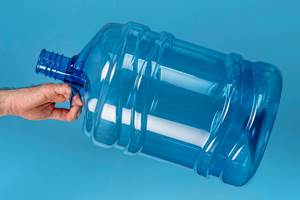Compression Molded PET Preforms Challenge Injection Molding
Lower cost, higher quality and productivity, and the potential for lightweighting beyond anything yet seen are benefits claimed for a new continuous compression molding process for making PET bottle preforms.
Lower cost, higher quality and productivity, and the potential for lightweighting beyond anything yet seen are benefits claimed for a new continuous compression molding process for making PET bottle preforms. The Preform Advance Molding (PAM) process was introduced at the recent K 2007 show in Dusseldorf by Sacmi Imola S.C. of Italy. It’s still too early for PAM to offer a serious challenge to injection molding. By next month, Sacmi plans to have built two machines for in-house development use and hopes to commercialize the system in the second half of this year.
While potentially fomenting a battle between injection and compression molding for the preform ┤¾¤¾┤½├¢, SACMI has a foot in both camps. Its PAM system is an outgrowth of its established machinery for continuous compression molding of beverage-bottle caps and other closures, which now can turn out up to 100,000 caps/hr. On the other hand, Sacmi recently established a PET division to offer complete preform manufacturing systems encompassing injection presses from its Negri Bossi subsidiary (which now incorporates two other Italian press makers with preform experience, Oima and BM Biraghi), as well as Negri Bossi robots and Sacmi’s preform molds and vision inspection systems.
CONSISTENT PREFORM WEIGHT | |
| (0.5L CSD, 98-MM LONG, PCO 1810 NECK) | |
| Average Weight | 22.955 g |
| Minimum Weight | 22.911 g |
| Maximum Weight | 22.997 g |
| Range | 0.086 g |
| 3 Std. Dev. | 0.057 g |
(0.25%) | |
How It Works
Figures 1 and 2 (shown on right) show the overall process layout and sequence of operations. As with Sacmi’s cap-molding systems, PAM starts with an extruder. The current-generation PAM002 system uses a 120-mm model from Amut of Italy that can process 1760 lb/hr of PET. It continuously extrudes a cylindrical parison, which descends from a vertical die and is cut by a knife into a slug or “gob.” The gob is grabbed by an insertion carousel and dropped into one of 48 mold cavities on a spinning carousel. As it turns (9.5 to 10.5 rpm), the cavities rise to meet the cores and thread splits and mold each preform under 2 tons of force. (PAM systems can be built with up to 5 tons per cavity.) The molding carousel processes standard 0.5L carbonated soft-drink (CSD) preforms—23-g weight, 120-mm long, PCO 1810 neck finish—at up to 450 to 500/hr.
After a 6.5-sec molding cycle (approx. 90% of which involves actual pressing), the core and neck splits lift the preform out of the cavity and another robot transfers the preforms to a post-cooling carousel. The latter has 256 sleeves in which preforms are air-cooled inside and out for the equivalent of 5.3 molding cycles. The preforms leave the system aligned on a conveyor, which permits integration of 100% vision inspection (at up to 650 preforms/min with Sacmi’s PVS-1 multi-camera system) or direct delivery to a stretch-blowing machine.
Better Than Injection?
Sacmi claims several benefits for its new process:
- Quality—According to injection molding sales manager Marco Savorani, “Fifty to sixty percent of preform quality problems are related to the gate. This system has no gate!” Preforms thus avoid problems of voids, pinholes, or crystallinity at the gate, as well as long or pulled gate vestiges. The preforms are handled carefully so they are not scratched or dented.
- Savorani also cites higher preform consistency. “Each cavity is independent. There are no ‘critical’ cavities as in injection molding,” he says (see table). He also says the preforms have lower acetaldehyde (AA) content because the melt is exposed to less shear than during injection and is molded at only 500 to 536 F, which is 27° to 36° lower than usual. Savorani says tests on preforms molded of 0.8 IV PET showed AA content of 2.5 to 2.6 ppm.
- Productivity—Lower temperature molding, faster filling, and separate cooling allow for faster molding cycles. For an output of 27,000 preforms/hr, injection molding requires 72 mold cavities, while PAM needs only 48.
- Cost—Savorani says the price of a PAM system will be competitive with a preform injection system of similar output capacity. Molding at lower temperature and tonnage saves energy, Sacmi notes. But the biggest savings come from reduced scrap and potential lightweighting. Preforms without a thick gate vestige are lighter to start with and perhaps can have a thinner bottom because now the bottom area can be stretched, Savorani points out. Most exciting of all, he notes, is the potential to use higher-viscosity resins than have been usable with injection molding—perhaps as high as 0.87 IV, though such a resin is not commercially available at present. Higher IV means higher strength, which would permit further lightweighting. The limit of that weight reduction is still being defined.
Related Content
Lighter, Higher Performance Base Design for Premium rPET Bottles
Sidel’s StarLITE-R Premium base for thicker rPET bottles ensures bottle stability in high-speed production, while saving energy.
Read MoreStretching the Boundaries of Large PET Containers
NPE2024: Cypet shows off new capabilities for its ISBM machines.
Read MoreSACMI’s PET Bottle and Labeling Machinery Integrated Into Omnia Techologies
SACMI Bottling and Labelling are now subunits of Omnia’s ACMI.
Read MoreFirst Water Bottles With Ultrathin Glass Coating
Long used for sensitive juices and carbonated soft drinks, KHS Freshsafe PET Plasmax vapor-deposited glass coating is now providing freshness and flavor protection for PET mineral water bottles.
Read MoreRead Next
See Recyclers Close the Loop on Trade Show Production Scrap at NPE2024
A collaboration between show organizer PLASTICS, recycler CPR and size reduction experts WEIMA and Conair recovered and recycled all production scrap at NPE2024.
Read MoreLead the Conversation, Change the Conversation
Coverage of single-use plastics can be both misleading and demoralizing. Here are 10 tips for changing the perception of the plastics industry at your company and in your community.
Read MoreBeyond Prototypes: 8 Ways the Plastics Industry Is Using 3D Printing
Plastics processors are finding applications for 3D printing around the plant and across the supply chain. Here are 8 examples to look for at NPE2024.
Read More














